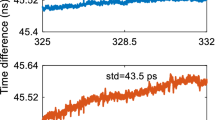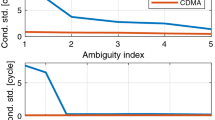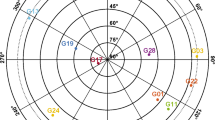Abstract
Fast ambiguity resolution is a major challenge for GLONASS phase-based applications. The integer-estimable frequency-division multiple-access (IE-FDMA) model succeeds in formulating a set of estimable GLONASS phase ambiguities and preserving the integer property, to which the classical integer ambiguity resolution, typically the least-squares ambiguity decorrelation adjustment (LAMBDA), becomes readily applicable. The initial assessment of the IE-FDMA model demonstrated instantaneous ambiguity resolution capability in case of short-baseline real-time kinematic (RTK) positioning based on ionosphere-fixed formulation, in which the data processing strategy is window (batch)-based least-squares estimation with window length ranging from one to a few epochs. Here, we extend the applicability of the IE-FDMA model to Kalman-filter-based, ionosphere-fixed, ionosphere-weighted, and ionosphere-free cases, which are, respectively, adoptable for short-, medium-, and long-baseline RTK positioning. To adapt the IE-FDMA model to the Kalman filter, we estimate, at each epoch, first the estimable ambiguities, then transform them into integer-estimable ones, and finally resolve them into correct integers. This enables the rigorous integer ambiguity resolution and, at the same time, eases the recursive construction of integer-estimable ambiguities. We analyze global positioning system (GPS) and GLONASS data of nine baselines with lengths varying from several meters to more than one hundred kilometers. The results demonstrate the feasibility of fast ambiguity resolution not only for the GLONASS phase-only short-baseline RTK positioning, but for the GPS + GLONASS medium- and long-baseline RTK positioning as well. In all cases, the fixed solution with faster (several-minutes) convergence and higher (centimeter-level) precision indicates the benefits from GLONASS ambiguity resolution as compared to the float solution. Moreover, the dual-system solution with decreased ambiguity dilution of precision (ADOP) and improved positioning precision confirms the advantages of integrating GLONASS with GPS in contrast to the GPS-only situation.














Similar content being viewed by others
Data availability
RINEX data collected in Perth, Australia can be accessed at https://saegnss2.curtin.edu.au/ldc/; RINEX data acquired from the National Geodetic Survey (NGS) CORS network in the United States (US) can be downloaded at ftp://geodesy.noaa.gov/cors/; RINEX data collected in Wuhan, China can be obtained at https://pan.baidu.com/s/1iacpGNmDHgg9JboKiGl_7w (Extraction code: 3r2l).
References
Aggrey J, Bisnath S (2016) Dependence of GLONASS pseudorange inter-frequency bias on receiver-antenna combination and impact on precise point positioning. Navigation 63(4):379–391
Banville S, Collins P, Lahaye F (2018) Model comparison for GLONASS RTK with low-cost receivers. GPS Solut 22(2):52. https://doi.org/10.1007/s10291-018-0712-3
Bona P (2000) Precision, cross correlation, and time correlation of GPS phase and code observations. GPS Solut 4(2):3–13
Euler HJ, Goad CC (1991) On optimal filtering of GPS dual frequency observations without using orbit information. Bull Géod 65(2):130–143
Geng J, Zhao Q, Shi C, Liu J (2017) A review on the inter-frequency biases of GLONASS carrier-phase data. J Geodesy 91(3):329–340
Hakansson M, Jensen ABO, Horemuz M, Hedling G (2017) Review of code and phase biases in multi-GNSS positioning. GPS Solut 21(3):849–860
Hou P, Zhang B, Yuan Y, Zhang X, Zha J (2019) Stochastic modeling of BDS2/3 observations with application to RTD/RTK positioning. Meas Sci Technol 30(9):095002. https://doi.org/10.1088/1361-6501/ab1fad
Khodabandeh A, Teunissen PJG (2019) Integer estimability in GNSS networks. J Geodesy 93(9):1805–1819. https://doi.org/10.1007/s00190-019-01282-6
Koch KR (1999) Parameter estimation and hypothesis testing in linear models. Springer, Berlin
Leick A (1998) GLONASS satellite surveying. J Surv Eng 124(2):91–99
Leick A, Rapoport L, Tatarnikov D (2015) GPS satellite surveying. Wiley, Hoboken
Li B (2016) Stochastic modeling of triple-frequency BeiDou signals: estimation, assessment and impact analysis. J Geodesy 90(7):593–610
Li B, Shen Y, Xu P (2008) Assessment of stochastic models for GPS measurements with different types of receivers. Chin Sci Bull 53(20):3219–3225
Odijk D (2003) Ionosphere-Free phase combinations for modernized GPS. J Surv Eng 129(4):165–173
Odijk D, Teunissen PJG (2008) ADOP in closed form for a hierarchy of multi-frequency single-baseline GNSS models. J Geodesy 82(8):473
Odolinski R, Teunissen PJG (2017) Low-cost, high-precision, single-frequency GPS-BDS RTK positioning. GPS Solut 21(3):1315–1330
Odolinski R, Teunissen PJG, Odijk D (2015) Combined GPS + BDS for short to long baseline RTK positioning. Meas Sci Technol 26(4):045801
Schaffrin B, Bock Y (1988) A unified scheme for processing GPS dual-band phase observations. Bull Geod 62(2):142–160
Sleewaegen JSA, Wilde W, Boon F, Willems T (2012) Demystifying GLONASS inter-frequency carrier phase biases. Inside GNSS 7(3):57–61
Takac T (2009) GLONASS inter-frequency biases and ambiguity resolution. Inside GNSS 4(2):24–28
Teunissen PJG (1995) The least-squares ambiguity decorrelation adjustment: a method for fast GPS integer ambiguity estimation. J Geodesy 70(1–2):65–82
Teunissen PJG (1997) A canonical theory for short GPS baselines. J Geodesy 71(6):320–336
Teunissen PJG (1998) The Ionosphere-weighted GPS baseline precision in canonical form. J Geodesy 72(2):107–111
Teunissen PJG (2001) Integer estimation in the presence of biases. J Geodesy 75(7–8):399–407
Teunissen PJG (2003) Theory of integer equivariant estimation with application to GNSS. J Geodesy 77(7–8):402–410
Teunissen PJG (2019) A new GLONASS FDMA model. GPS Solut 23(4):100. https://doi.org/10.1007/s10291-019-0889-0
Teunissen PJG, Joosten P, Odijk D (1999) The reliability of GPS ambiguity resolution. GPS Solut 2(3):63–69
Teunissen PJG, Khodabandeh A (2019) GLONASS ambiguity resolution. GPS Solut 23(4):101. https://doi.org/10.1007/s10291-019-0890-7
Teunissen PJG, Kleusberg A (2012) GPS for geodesy. Springer, Berlin
Teunissen PJG, Montenbruck O (2017) Springer handbook of global navigation satellite systems. Springer, Berlin
Tian Y, Ge M, Neitzel F (2015) Particle filter-based estimation of inter-frequency phase bias for real-time GLONASS integer ambiguity resolution. J Geodesy 89(11):1145–1158
Wang J, Rizos C, Stewart MP, Leick A (2001) GPS and GLONASS integration: modeling and ambiguity resolution issues. GPS Solut 5(1):55–64
Wang K, Khodabandeh A, Teunissen PJG (2018) Five-frequency Galileo long-baseline ambiguity resolution with multipath mitigation. GPS Solut 22(3):75. https://doi.org/10.1007/s10291-018-0738-6
Wanninger L (2012) Carrier-phase inter-frequency biases of GLONASS receivers. J Geodesy 86(2):139–148
Yao Y, Hu M, Xu X, He Y (2017) GLONASS inter-frequency phase bias rate estimation by single-epoch or Kalman filter algorithm. GPS Solut 21(4):1871–1882
Zhang B, Hou P, Liu T, Yuan Y (2020) A single-receiver geometry-free approach to stochastic modeling of multi-frequency GNSS observables. J Geodesy 94(4):37. https://doi.org/10.1007/s00190-020-01366-8
Acknowledgments
This work was partially funded by the National Natural Science Foundation of China (No. 41774042), the BDS Industrialization Project (No. GFZX030302030201-2), the Scientific Instrument Developing Project of the Chinese Academy of Sciences (No. YJKYYQ20190063), and the National Key Research Program of China Collaborative Precision Positioning Project (No. 2016YFB0501900). The second author is supported by the CAS Pioneer Hundred Talents Program.
Author information
Authors and Affiliations
Corresponding author
Additional information
Publisher's Note
Springer Nature remains neutral with regard to jurisdictional claims in published maps and institutional affiliations.
Rights and permissions
About this article
Cite this article
Hou, P., Zhang, B. & Liu, T. Integer-estimable GLONASS FDMA model as applied to Kalman-filter-based short- to long-baseline RTK positioning. GPS Solut 24, 93 (2020). https://doi.org/10.1007/s10291-020-01008-8
Received:
Accepted:
Published:
DOI: https://doi.org/10.1007/s10291-020-01008-8




